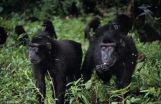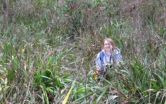(Press-News.org) A new USC study finds evidence suggesting that the brain works hard to understand those who have different bodies when watching them in action.
According to the study's lead author, the finding supports initiatives to include more individuals with physical differences in mainstream media – such as Sarah Herron, a contestant on ABC's The Bachelor this season, who was born with a foreshortened left arm.
"Generally, it's considered impolite to stare. But what these results suggest is that we need to look. It's through this visual experience that we're able to make sense of those different from ourselves," said Sook-Lei Liew, who is the lead author of a paper on the research that appeared online this month in NeuroImage.
Liew, now a postdoctoral researcher at the National Institutes of Health, completed the research while she was a doctorate student at USC, working with Tong Sheng, a fellow graduate student, and Lisa Aziz-Zadeh, an assistant professor at the USC Dornsife Brain and Creativity Institute and the Division of Occupational Science and Occupational Therapy.
Liew, Sheng and Aziz-Zadeh monitored the brains of 19 typically developed individuals using functional magnetic resonance imaging (fMRI) while showing them a series of video clips. First they showed a typically developed person picking up objects and then a woman born without complete arms using her residual limbs to perform the same tasks.
The fMRI scans showed that parts of the motor network responsible for picking up objects by hand are activated when simply watching another person performing the task – physical evidence of participants attempting to use their own body representations to represent the people they are watching on screen.
The thing that surprised the researchers was that same part of the motor network was activated to a greater degree when watching residual limbs doing the same activity. Participants' brains worked overtime to process the use of a type of limb that they did not have.
"Interestingly, we found that individual differences in trait empathy affected the result," Aziz-Zadeh said. "That is, individuals who scored higher in their ability to empathize with other people showed more activity in motor regions when observing actions made by residual limbs."
Further, when shown more clips of the woman with a residual limb—clips that lasted minutes instead of seconds—the fMRI scans showed similar motor network activity, which returned to a level comparable to when they were watching typically developed individuals, suggesting that increased visual exposure improved understanding.
"Stigma is one of the main challenges for people with physical differences," Liew said. "We need to examine why stigmas exist and what we can do to alleviate them. Learning about disabilities visually is one way that we can begin to map their experiences onto our own brains."
###
This research was supported by the National Science Foundation Graduate Research Fellowship, The USC Provost's PhD Fellowship, the Division of Occupational Science and Occupational Therapy, the Dana and David Dornsife Neuroimaging Center and the Brain and Creativity Institute. END
Learn to be more understanding by watching The Bachelor (this season, anyway)
New research finds evidence that seeing individuals with different bodies, such as amputees or those born with residual limbs, causes the brain's motor network to work hard to process physical differences
2013-01-23
ELSE PRESS RELEASES FROM THIS DATE:
New way to identify 'smoked' grapes and wines
2013-01-23
With climate change sparking concern about an increased risk of wildfires, scientists are reporting development of a way to detect grapes exposed to smoke from those fires, which otherwise could be vented into bad-tasting wine. Their report on the method for detecting smoke taint in both grapes and wine appears in ACS' Journal of Agricultural and Food Chemistry.
Yoji Hayasaka and colleagues point out that Australia and other areas of the world are experiencing an increase in bush and wildfires, which may continue and intensify with global climate change. Smoke from those ...
Scientists underestimated potential for Tohoku quake. Now what?
2013-01-23
CORVALLIS, Ore. – The massive Tohoku, Japan, earthquake in 2011 and Sumatra-Andaman superquake in 2004 stunned scientists because neither region was thought to be capable of producing a megathrust earthquake with a magnitude exceeding 8.4.
Now earthquake scientists are going back to the proverbial drawing board and admitting that existing predictive models looking at maximum earthquake size are no longer valid.
In a new analysis published in the journal Seismological Research Letters, a team of scientists led by Oregon State University's Chris Goldfinger describes how ...
Putting the squeeze on cells
2013-01-23
CAMBRIDGE, Mass. — Living cells are surrounded by a membrane that tightly regulates what gets in and out of the cell. This barrier is necessary for cells to control their internal environment, but it makes it more difficult for scientists to deliver large molecules such as nanoparticles for imaging, or proteins that can reprogram them into pluripotent stem cells.
Researchers from MIT have now found a safe and efficient way to get large molecules through the cell membrane, by squeezing the cells through a narrow constriction that opens up tiny, temporary holes in the membrane. ...
Panel recommends changing name of common disorder in women
2013-01-23
An independent panel convened by the National Institutes of Health has concluded that the name of a common hormone disorder in women, polycystic ovary syndrome (PCOS), causes confusion and is a barrier to research progress and effective patient care. The current name focuses on a criterion — ovarian cysts — which is neither necessary nor sufficient to diagnose the syndrome. In a report released today, the panel recommended assigning a new name that more accurately reflects the disorder.
"The name PCOS is a distraction that impedes progress. It is time to assign a name ...
Better outlook for dwindling black macaque population in Indonesia
2013-01-23
Since at least the 1970s, the population of critically endangered Sulawesi black macaques living in an Indonesian nature reserve has been dropping. But a new study by researchers at the University of Washington and in Indonesia shows that the population has stabilized over the past decade.
The findings, published in the January issue of the American Journal of Primatology, are from the longest ongoing survey of Macaca nigra and are among the first evidence that the monkeys may be in better shape.
"Fifteen years ago it looked like this macaque population would continue ...
Treatment targeting PI3K may delay resistance to anti-HER2 therapy in breast cancer patients
2013-01-23
PHILADELPHIA — Patients with HER2-positive breast cancer being treated with anti-HER2 therapy may be able to prevent or delay resistance to the therapy with the addition of a phosphatidylinositol-3 kinase inhibitor to their treatment regimens.
The data, published in Cancer Research, a journal of the American Association for Cancer Research, indicated that failure of the anti-HER2 antibody trastuzumab to block HER2 from activating the phosphatidylinositol-3 kinase (PI3K) signaling pathway can lead to resistance to treatment. Therefore, dual simultaneous inhibition of ...
Global plant diversity hinges on local battles against invasive species
2013-01-23
In Missouri forests, dense thickets of invasive honeysuckle decrease the light available to other plants, hog the attention of pollinators and offer nutrient-stingy berries to migrating birds. They also release toxins that decrease the germination of nearby native plants. Why, then, do studies of invasive species come to different conclusions about their effects and lead some organizations to suggest we accept their presence?
Biologists Kristin Powell, Tiffany Knight and Jon Chase of Washington University in St. Louis have found an answer.
Most studies of the effects ...
More efficient way to make popular prescription medication
2013-01-23
In a demonstration of the power of green chemistry, scientists are reporting development of a new and more efficient process for making one of the most costly and widely used medications for severe mental illness. Described in a report in the journal ACS Sustainable Chemistry & Engineering, it produces larger amounts of the medication than the existing commercial process while reducing the use of solvents and other potentially toxic substances.
Vijayavitthal T. Mathad and colleagues point out that paliperidone, marketed under the brand name Invega, is one of a new generation ...
Caloric restriction has a protective effect on chromosomes
2013-01-23
One of the indicators of a cell's health is the state of its DNA and containers—the chromosomes—so when these fuse together or suffer anomalies, they can become the source of illnesses like cancer and/or ageing processes.
According to a study carried out by a team led by María Blasco, the director of the Spanish National Cancer Research Centre (CNIO) and head of the Telomeres and Telomerase Group, a sustained lowering of food intake over time results in an increase of telomere length—the ends of chromosomes—in adult mice, which has a protective effect on the DNA and genetic ...
Products That Make a Difference: Discover MaxiAids' 2013/14 Catalog
2013-01-23
MaxiAids Products for Independent Living (www.MaxiAids.com) has released their 2013/14 Catalog. Commonly accepted as the 'Reference Guide of the Industry,' the MaxiAids Catalog contains the largest available assortment of items that support active, healthy and independent lives.
The most viewed catalog in the industry, it has thousands of budget-friendly assistive items for all age groups, no matter what their special need is. See more clearly with magnified, talking or large print daily living items such as talking watches and large numbered clocks! Never oversleep ...
LAST 30 PRESS RELEASES:
New expert guidance urges caution before surgery for patients with treatment-resistant constipation
Solar hydrogen can now be produced efficiently without the scarce metal platinum
Sleeping in on weekends may help boost teens’ mental health
Study: Teens use cellphones for an hour a day at school
After more than two years of war, Palestinian children are hungry, denied education and “like the living dead”
The untold story of life with Prader-Willi syndrome - according to the siblings who live it
How the parasite that ‘gave up sex’ found more hosts – and why its victory won’t last
When is it time to jump? The boiling frog problem of AI use in physics education
Twitter data reveals partisan divide in understanding why pollen season's getting worse
AI is quick but risky for updating old software
Revolutionizing biosecurity: new multi-omics framework to transform invasive species management
From ancient herb to modern medicine: new review unveils the multi-targeted healing potential of Borago officinalis
Building a global scientific community: Biological Diversity Journal announces dual recruitment of Editorial Board and Youth Editorial Board members
Microbes that break down antibiotics help protect ecosystems under drug pollution
Smart biochar that remembers pollutants offers a new way to clean water and recycle biomass
Rice genes matter more than domestication in shaping plant microbiomes
Ticking time bomb: Some farmers report as many as 70 tick encounters over a 6-month period
Turning garden and crop waste into plastics
Scientists discover ‘platypus galaxies’ in the early universe
Seeing thyroid cancer in a new light: when AI meets label-free imaging in the operating room
Neutrophil-to-lymphocyte ratio may aid risk stratification in depressive disorder
2026 Seismological Society of America Annual Meeting
AI-powered ECG analysis offers promising path for early detection of chronic obstructive pulmonary disease, says Mount Sinai researchers
GIMM uncovers flaws in lab-grown heart cells and paves the way for improved treatments
Cracking the evolutionary code of sleep
Medications could help the aging brain cope with surgery, memory impairment
Back pain linked to worse sleep years later in men over 65, according to study
CDC urges ‘shared decision-making’ on some childhood vaccines; many unclear about what that means
New research finds that an ‘equal treatment’ approach to economic opportunity advertising can backfire
Researchers create shape-shifting, self-navigating microparticles
[Press-News.org] Learn to be more understanding by watching The Bachelor (this season, anyway)New research finds evidence that seeing individuals with different bodies, such as amputees or those born with residual limbs, causes the brain's motor network to work hard to process physical differences


